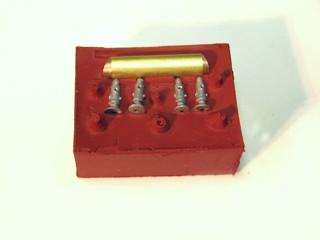
Casting Metal
This appeared Modelspoormagazine 70. More text and pictures can be found there.
I needed special buffers, not existing as a model any more. A friend had some models, so copying them was the only possibility. This was a very good reason to try casting low-melting metal.
There are many different low-melting alloys, the best known is solder: A lead and tin alloy, mostly a 60/40 mixture. It melts at 250°C. There are other alloys with lower melting temperatures, of which the very toxic Woods Metal (67°C) is known by illusionists.
Since a couple of years, due to its health hazard, lead is no longer allowed in plumbing and industrial electronics.
For plumbing, an almost tin-only alloy is used. I didn't experiment with this metal. Feel free to try it and tell me the results!

The buffers I wanted to cast were used a lot in the fiftees Belgium, especially on freight wagons. The photo shows the real ones on a museum wagon. |

The model buffers were assembled first and will be cast as a whole. From some sheet styrene, a made an open box and a matching pressing tool.
|
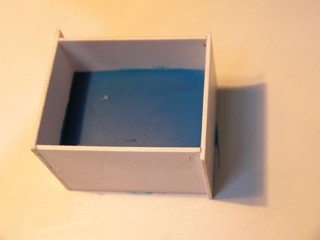
Some cheap toy clay was shaped into a sphere and placed in the open box and pressed to a smooth, flat surface.
The mold case is ready to accept the models. |
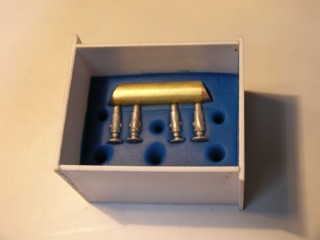
A rather thick tube is placed on top. This will distribute the cast metal into the actual model shapes, lined up to allow a smooth flowing of the hot metal.
As this will be a two-halves mould,
pits in the clay will ensure the second halve can be lined up nicely. |

We need a special silicon rubber for the mould, capable of resisting high temperatures. I found it at VossChemie, allowing casting temperatures up to 380°C.
Some loosening wax(-spray) is needed to allow the two halves of the mould to be separated after casting them.
|
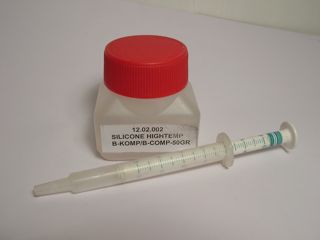
The siliconen rubber has two components, which have to be mixed in a 1/20 weight proportion. As I needed 18cc of rubber, this meant 30 grams of rubber, mixed with 1,5cc of hardener. |
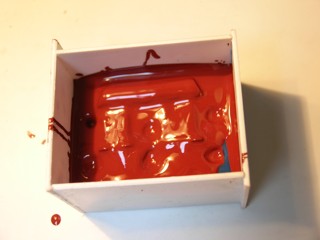
The heat resistant silicon rubber hardens a lot faster than common "cold" rubber. To prevent trapped air bubbles in the mould, its best to spread a thin layer first and cast the rest of the carefuly mixed rubber later.
|
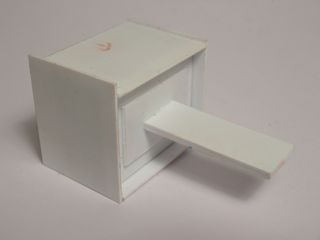
After the first halve has hardened, we can push it out of the bottomlesss box, together with the toy clay and the master model. The mould halve can now be cleaned. |

This cleaning should be done very careful, but thorough. Some casting sprew might be present and should be cut away carefuly too.
The master models can now be put in place again, the halve mould is placed back in the styrene box and sprayed with the loosening wax. After drying, a second mixture of silicon rubber can be cast.
|
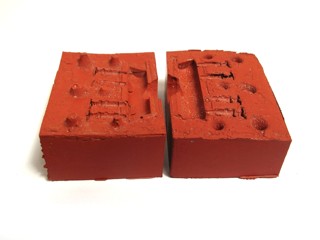
After about six hours both mould halves can be pushed out of the styrene box. The moulds are cleaned again: the wax ans some error casting must be removed.
We just need an shaped opening on top to fill the mould and some air channels towards the bottom to allow a smooth and complete casting. |
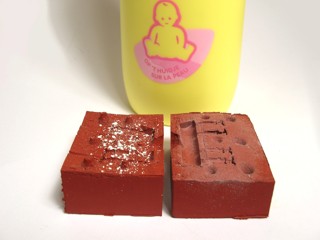
As the needs to flow as smoothly as possible, we use talc powder, spread with a soft brush in every corner of the mould.
We need of course the metal
itself to cast copies. Tin/lead mixtures are the best to use. I used some old plumbers solder (55/45). |

We need a little heat-resisting pot, a spoon with an heat-insulated shaft and some heat. This can be a small gas heater as used for camping.
The slowly melting metal is very hot: be careful!
|
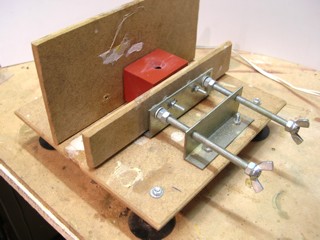
As the metal melts, the mould can be placed in a clamp. The vibrating device I made earlier is very useful in the upcoming casting proces. |
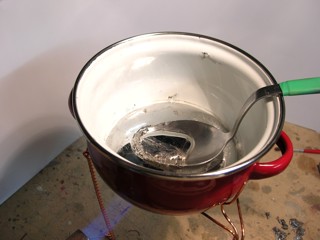
Especially when using older - more exposed metal is used, a thin coat of "rust" appears on top of the melted alloy. As this is not useable, it should be scraped off and disposed.
Put the spoon in the cleaned alloy, let it heat up a bit and get a little melted metal. Cast it into the mould in one movement.
|

As the inside volume is small, some metal might be spilled. The vibrations let it sink a bit before the metal cools and sets.
Setting occurs relatively quick, but this doesn't mean the metal is cold enough to touch! Use a pair of tweezers to get the cast metal out of the mold and let it cool down on a suitable surface. When cooled, the castings can be cut of, the remainings can be used for next castings.
|
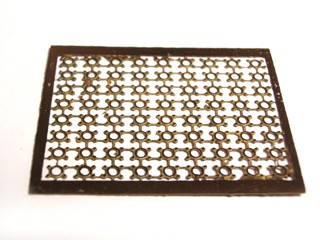
The plates between the actual buffers and the car's frame are etched. Some filing might be needed, but surely most plates will be quite useable. The etching process isn't part of this story, so it isn't described now. |

A freight car needed new buffers after colliding with the floor... I removed the old buffer's remains, sanded the front beam and glued the new buffer system in place.
|
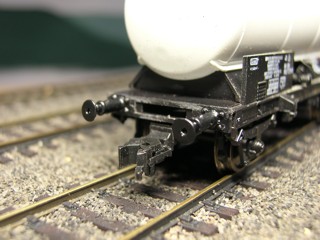
The flat buffer should be placed at the right side, so prototype pictures are needed.
|
Casting metal isn't really trickier than casting resins. It's easier, as we don't need to mix any components in the right proportion. It's more difficult, as we're dealing with hot substances. This means: be cautious! I want you to enjoy our lovely hobby for a long time!




